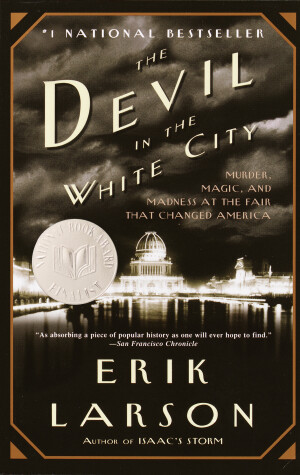
NEW YORK TIMES BESTSELLER • The true tale of the 1893 World's Fair in Chicago and the cunning serial killer who used the magic and majesty of the fair to lure his victims to their death.
“Relentlessly fuses history and entertainment to give this nonfiction book the dramatic effect of a novel .... It doesn’t hurt that this truth is stranger than fiction.” —The New York Times
Combining meticulous research with nail-biting storytelling, Erik Larson has crafted a narrative with all the wonder of newly discovered history and the thrills of the best fiction.
Two men, each handsome and unusually adept at his chosen work, embodied an element of the great dynamic that characterized America’s rush toward the twentieth century. The architect was Daniel Hudson Burnham, the fair’s brilliant director of works and the builder of many of the country’s most important structures, including the Flatiron Building in New York and Union Station in Washington, D.C. The murderer was Henry H. Holmes, a young doctor who, in a malign parody of the White City, built his “World’s Fair Hotel” just west of the fairgrounds—a torture palace complete with dissection table, gas chamber, and 3,000-degree crematorium.
Burnham overcame tremendous obstacles and tragedies as he organized the talents of Frederick Law Olmsted, Charles McKim, Louis Sullivan, and others to transform swampy Jackson Park into the White City, while Holmes used the attraction of the great fair and his own satanic charms to lure scores of young women to their deaths. What makes the story all the more chilling is that Holmes really lived, walking the grounds of that dream city by the lake.
The Devil in the White City draws the reader into the enchantment of the Guilded Age, made all the more appealing by a supporting cast of real-life characters, including Buffalo Bill, Theodore Dreiser, Susan B. Anthony, Thomas Edison, Archduke Francis Ferdinand, and others. Erik Larson’s gifts as a storyteller are magnificently displayed in this rich narrative of the master builder, the killer, and the great fair that obsessed them both.
- ISBN10 0375725601
- ISBN13 9780375725609
- Publish Date 10 February 2004 (first published 11 February 2003)
- Publish Status Active
- Publish Country US
- Publisher Random House USA Inc
- Imprint Vintage Books
- Format Paperback (US Trade)
- Pages 464
- Language English
- URL https://penguinrandomhouse.com/books/isbn/9780375725609
Reviews


readingwithwrin
This book wasn’t exactly what I expected it to be and that why it took me almost a month to read. Having said that though I did really enjoy it and I liked learning so much about the Chicago Worlds Fair, I just wish more had been focused on H.H Holmes.
I knew some about the worlds fair, and the things we got out of it that are still around today, but I didn’t know how much really went into making it and how it was a rush at times.
Larson did make it interesting to learn so much, but I do think at least for me that it’s one that had to be read slowly.

gmcgregor
I was super looking forward to this when I started it: with the huge amount of praise it got, and how much I enjoyed Larson's most recent Dead Wake, it seemed like it was going to easily be a new favorite. But I just didn't get really into it the way I was hoping. Which doesn't mean it wasn't good! It was, quite good in fact. But Larson's threading together of the different stories wasn't quite as skilled as it was in Dead Wake. Since I was in the middle of being stressed out about planning my own event as I was reading it (less than a month before my wedding), the long recounting of the delays and problems of planning and building the Fair just gave me anxiety. But I think even without my personal baggage, I would have found this portion of the book a little overlong. I get what Larson's trying to do: you know it did come together and was successful in the end (he tells you that much right from the beginning), and as he recounts mishap after mishap, it's supposed to keep you hooked and wonder how in the world it got pulled off. But at a certain point I just wanted to the Fair to start already because I knew it was going to and I was tired of hearing about how it almost didn't.
The part of the story about the Fair is so dominant that the part about the serial killer (which was honestly the part I was most interested in) gets a little bit of the short shrift. Holmes and his story kind of lurk around the outside edges, which I suppose is appropriate since lurking around the edges of the Fair is exactly what Holmes did in real life. But every time the book turned back to the Fair from Holmes I groaned a little inside, because I found the latter so much more compelling. The book effectively ends by devoting itself to wrapping up Holmes' plotline, and it was the first time I felt reluctant to put the book down since I started it. On the whole the book is well-written, interesting, and definitely worth a read, but don't go in expecting it to be mostly about one of America's first serial killers or you might be a little disappointed.

Liz (Bent Bookworm)

Terri M. LeBlanc

ibeforem
But Holmes isn’t the real star of this book, and that was the biggest surprise. I ended up being much more enthralled by the story of the World’s Fair than in Holmes story. The book follows the fair from it’s earliest planning stages to the bitter end. It’s really amazing the things that became popular because of this fair. It was a big reason why Tesla’s A.C. won out over Edison’s D.C.. The Ferris Wheel was invented. The largest buildings of the time were built. It’s when the term "midway" was coined. Food products like Cracker Jack, Juicy Fruit, and Shredded Wheat were introduced. And there was so much more; it really was an amazing event for the country.
Unfortunately, because the book is straight non-fiction, rather than creative non-fiction, it can get a little dry in places. There’s really only so many times you need to tell me that the landscape designer (who, by the way, also designed Central Park and the grounds of the Biltmore), was extremely particular. Beyond that, I found it to be a very interesting piece of history.

Eve1972

empressbrooke
Although I imagine I appreciated the book more than someone who hasn't lived in Chicago, familiarity with the city is definitely not required. The Chicago of the 1880s is not the Chicago I know, and Larson does an excellent job putting things into perspective so that modern readers understand why certain things mattered or were different back then.
Larson's research is meticulous; anything that is in quotation marks is a direct quote from a primary source. Thus, the quotations serve less as dialogue, and more as support and evidence for the rest of the text. Larson doesn't litter the pages with footnotes and citations, but does include his works cited information in the back in a way that makes it easy to follow up on certain topics that might raise the reader's interest. I found it helpful to read the end notes, where the author explains how he decided to portray Holmes, before reading anything else.
If you like history or "the truth is stranger than fiction" stories, Devil is a great book, and one that doesn't take too much time to read.
